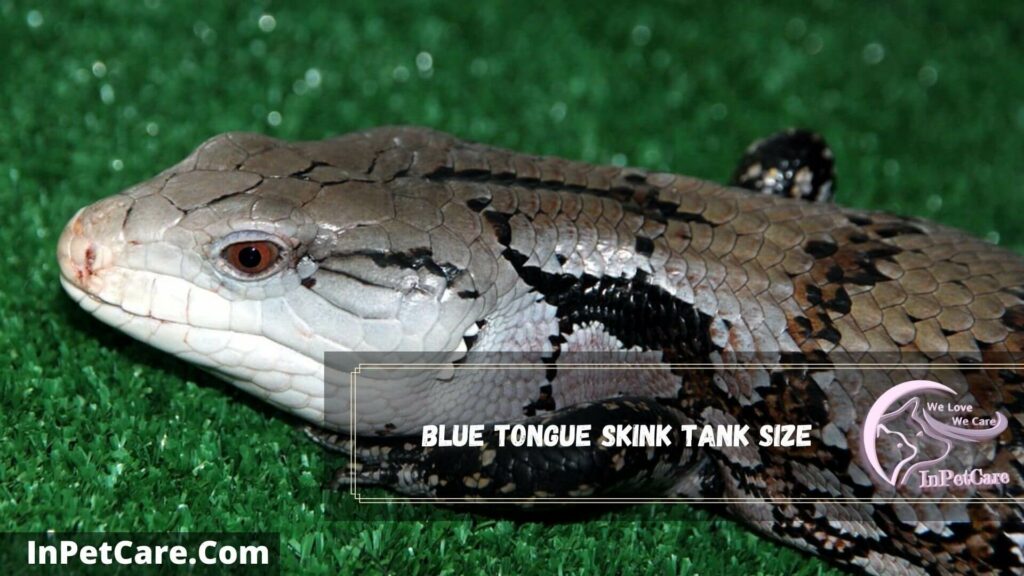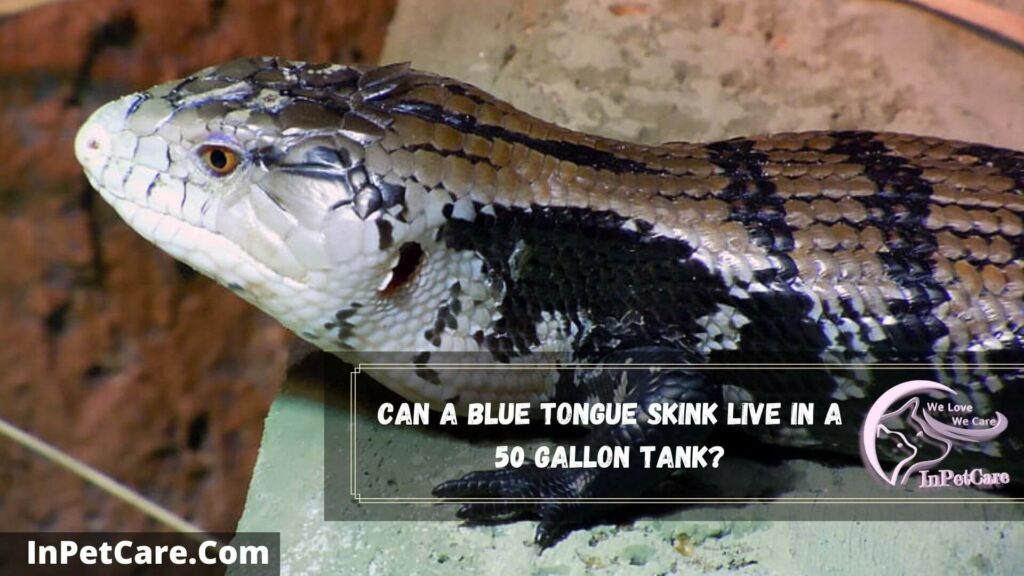Do you want to know what size tank for blue tongue skinks to choose? In this article, I will talk about what size enclosure for blue tongue skink is best. We will also talk about how big a tank for a blue tongue skink is needed according to their size and age. Before I tell you what size tank a blue tongue skink needs, you need to measure weight and the size of your skink.
What Size Tank Does A Blue Tongue Skink Need?
Juvenile skinks under 25 cm can be kept in a tank measuring 60×45 cm or more prominent. On the other hand, the adult blue tongue skink needs a mesh top tank measuring 90×45 cm aur more. The bigger the tank is, the better it is for them to exercise, hide, play, and road round.
If you are considering housing more than one blue tongue skink in a single tank, then provide multiple hides, basking spots, and at least an extra 2-3 feet per lizard.
Bluetongue skink tends to be very territorial, and keeping two males in a single tank can result in territorial fights. Before you consider supporting more than one lizard, especially a blue tongue skink, in a single tank, please read our guide – can blue tongue skinks be held together?
Keep the tank away from the direct sunlight but somewhere in a room that is well lit. Your room should have a stable temperature of around 20-25° C, or you can use heat lamps and other devices to achieve that in the tank.
How Much Space Does A Blue Tongue Skink Need?
Juvenile blue tongue skinks need at least 35×50 cm of space as they love to climb. They will also need some vertical space with lots of branches. Whereas, an adult blue tongue skink needs at least 75×30 cm in length. The tank size and its space should increase as the skink grows.
Bluetongue tanks should have enough space to hide, retreat when frightened, exercise, run, play, and eat. They like giving territorial and offensive gestures, so they should have enough space to mark as their territory if two or more lizards are housed.
Being larger, blue tongue lizards are also very aggressive and can easily scare off aggravators. However, housing a skink will not take too much space other than its tank itself.
Tanks must be more significant to support their growth and size. If your blue tongue skinks can’t move, play, or exercise, it’s time to get them a bigger one.
Blue Tongue Skink Tank Size

Here, we will talk about the blue tongue skink species and its tank size requirement for proper housing.
Northern Blue Tongue Skink Tank Size
The Northern blue tongue skink tank should be at least 36 inches long, 18 inches wide by 10 inches tall. It must have a full-screen mesh top. The larger the tank is, the better it is. Adult blue tongue skin prefers a floor space rather than a climbing area compared to juvenile skinks.
Somewhere I have read that the northern skinks need at least 8 square feet of floor space. As Northern blue tongue Skinks are also very active, they will love to explore a bigger tank. You can even house Northern blue tongue skink juveniles in an adult-sized tank if it has many hiding places.
Being the largest of all skinks, the most diminutive cage recommended for adult blue tongue skink is 48×24×24 at least.
Halmahera Blue Tongue Skink Tank Size
Halmahera blue tongue skink tank should be at least 32 inches long by 18 inches wide by 12 inches tall. They are highly active and need high humidity levels of around 60-80 %.
These species of blue tongue skink prefer humidity levels of 80% or more to live happily in a rock system. The babies of the Halmahera blue tongue skink species should be housed in a minimum 15-gallon tank
Baby Blue Tongue Skink Tank Size
Baby blue tongue skink tends to be highly active and hides a lot. They need at least 10-20 gallon tanks to thrive and grow faster. As they grow, you need to relocate them to larger tanks.
Baby skinks can also be kept in an adult enclosure, but lots of hiding should be provided vertical space to climb. The best tank size for baby blue tongue skinks is 24×12×9.
Indonesian Blue Tongue Skink Tank Size
Indonesian blue tongue skink tends to be smaller than Northern blue tongue skink but will need the same tank size. Indonesian skin needs a glass terrarium of at least 48×24×18 with a minimum of 8 square feet of floor space.
Many experts have recommended keeping lizards like blue tongue skinks no smaller than a 120-gallon size.
How Much Does A Blue Tongue Skink Tank Cost?
For a blue tongue skink, a simple tank will cost you around $75 to $150, whereas a complete kit suitable to house a single skink cost typically between $200- $350, including heat lamps, lighting, substrate, and pads devices to get an accurate reading, and others.
Is A 40 Gallon Tank Good For A Blue Tongue Skink?
A 40-gallon tank is not suitable for blue tongue skinks over 8 months old. However, a 40-gallon tank size will be appropriate to house one or more Juveniles’ blue tongue skinks.
They tend to grow at least 1-2 feet long so they will need a larger enclosure. The smallest I recommend you for adult skinks is 55 gallons.
However, many other reptiles can be kept in a 40-gallon tank like Bearded Dragons, chameleons, General Geckos, and Leopard Geckos.
Can A Blue Tongue Skink Live In A 20 Gallon Tank?
A 20-gallon tank is way too small for an adult blue tongue skink to live. Being 1-2 feet long reptiles, they need larger tanks of at least 48×24×24. A 20-gallon tank is suitable for baby skinks. An adult blue tongue skink must have 8 feet of floor space.
In a 20-gallon tank, a blue tongue skink will not move freely and will feel stress. Keeping them in a small tank will result in stunted growth and stress them out.
Can A Blue Tongue Skink Live In A 50 Gallon Tank?

An adult blue tongue skink can be kept in a 50-gallon tank with floor space of around 7-8 square feet long. Adult ones don’t like climbing, so rule out vertical space or areas.
The substrate is required to maintain the humidity level, but it should not retain moisture. It would help if you also tried decorating the tank to mimic the natural desert-like environment for your skink.
All these things are not possible properly in a 50-gallon tank, so you must keep them in at least 55 gallons or larger tank. The larger the tank is, the more you can use decor and mimic its natural environment.
Plus, larger tanks with proper light & heat sources will also keep the blue tongue skink happy & active. Many owners debate the tank size in different forums, but the truth is that recommended tank size for housing a blue tongue skink healthy and Happy is at least 120 gallons.
Can You Keep A Blue Tongue Skink In A 55 Gallon Tank?
You can always keep an adult blue tongue skink in a 55-gallon tank, but it is not suitable for more than one. If you plan to keep one skink in a tank, 50 gallons is enough. Many same-sized baby skinks can also live in a 50-gallon tank if it has many hiding spaces and vertical spaces to climb.
Verdict
Wrapping Up: To be honest, I find blue tongue skinks happy, thriving, and healthy in a 120-gallon size tank. If you plan to keep a baby skink, then a 20-gallon size tank is enough, but not for adult ones.
Being 1-2 feet long lizards, they can be kept in 50-65 gallons rank as well, but blue tongue skink needs a larger tank if you are not always ready to take them out.
I hope I gave you all the information needed on what size tank does a blue tongue skink need. I have shared a valuable resource on how to care for blue tongue skinks to check out; if you have any other concerns regarding their housing setup, comment below.
I hope you will find this post helpful and share it with others to help their skinks thrive and be happy. See you in the other article till then, take care and goodbye.

94% of pet owners say their animal pal makes them smile more than once a day. In 2007, I realized that I was made for saving Animals. My father is a Vet, and I think every pet deserves one. I started this blog, “InPetCare”, in 2019 with my father to enlighten a wider audience.

